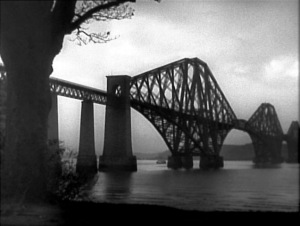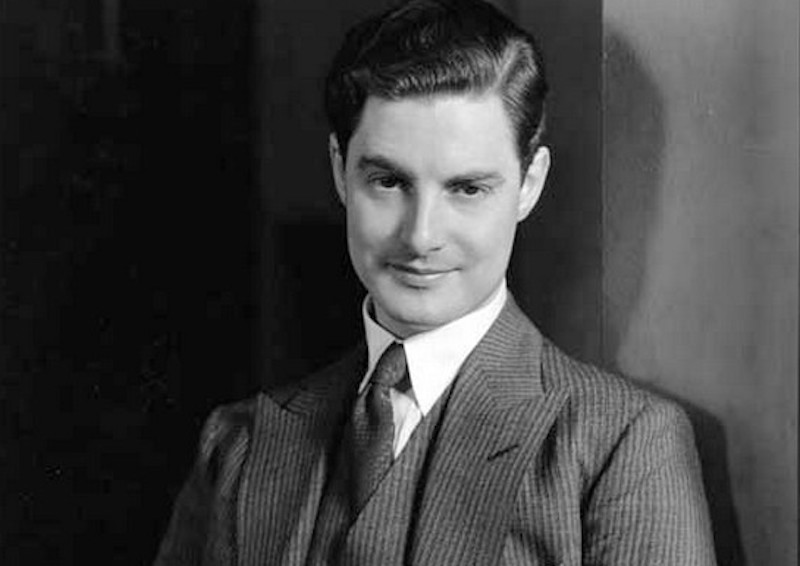Thank you to David Cairns for letting us reproduce this post about ‘The 39 Steps’ from his wonderful film blog, Shadowplay. (It helps if you know that David is based in Scotland!)

THE 39 STEPS, we all agree, is where Hitchcock’s thrillers really catch fire. He’d been making films since 1922, scoring considerable success, and many people, including Hitch himself, may have thought he had already shown what he could do — but this film raises the bar still further. It pleases me inanely that this is Hitchcock’s Scottish film, with Scottish settings, characters, and a source novel by Scotsman John Buchan (pronounced “buckin”). In Hitchcock’s movie, as in Buchan’s book, man of action Richard Hannay must follow the trail of a spy ring from London to the Highlands.
Hitch and collaborator Charles Bennett (who shares Hitch’s cameo in this one, a unique honour) famously abandoned or greatly altered large parts of the source novel, so that even the title became something of an irrelevance, to be explained away as brusquely as possible, but if you read the book (I did, years ago) it’s fun to see how elements are reconfigured: a throwaway line about a trip to the music hall is expanded by Hitchcock into a hilarious opening sequence, introducing hero Hannay, Mr. Memory the mnemonic genius, and a female spy calling herself Annabella Smith (Lucie Mannheim), whose murder sets things in motion.
Inspired by a surge of national spirit, I hopped on the train to retrace Hannay’s steps, but since I’m perennially cash-strapped, I only went from Edinburgh’s to the Forth Bridge. Hannay, fleeing the scene of a murder for which he’s automatically blamed, boards the Flying Scotsman locomotive, sharing a compartment with a traveller in ladies’ undergarments and another loudmouth, who seem to keep up a non-stop barrage of double entendres and man-of-the-world smut for the entire journey.
The train pulls into Waverley Station, Edinburgh, and one of the men flags down a news vendor. “Speak-a da English?” he asks. I wouldn’t try this in Scotland if I were you. The newspaper purchased carries news of Hannay’s pursuit, and the suspense is ramped up.
I don’t see any newsboys in the station when I’m there, but they have an entire newsagents shop, and a Burger King, which I feel gives me the edge on old Hannay. I hop in the train, with a ticket for North Queensferry, which means I’m crossing the bridge but no more. As Hannay is evading capture in his train, I’m snapping pictures out the window of mine. No knicker salesman, no compartment, no steam engine, no Madeleine Carroll…


There are actually two bridges now, the Road Bridge and the Rail Bridge, but the Road, a common suspension job, is regarded with contempt by locals, so when we say “the Forth Bridge” it’s always certain which we mean. A massive Victorian construction, it’s constantly being painted with a special paint, known as Forth Bridge Red. The Victorian engineers who constructed it said that as long as you kept painting it, the bridge would last forever. They start at one end, work there way to the other, then start again. It’s become the perfect metaphor for any unending, Sisyphean task.
Of course, when the bridge was privatized, the management idiots announced that they would no longer paint the bridge, since it was “too costly and dangerous,” which is an amazing bit of half-wittedness. MORE costly and dangerous than allowing it to rust? Sure enough, soon bits of corroded bridge were dropping onto North and South Queensferry, and a lot of money had to be spent repairing the structure. Painting has resumed.

The Forth Bridge, by Cairns.

The Forth Bridge, by Hitchcock.
One of the things that’s so outrageous about THE 39 STEPS is the use of narrative ellipsis to get around tricky plot problems. The first major cheat is near the start, when a woman is killed in Hannay’s flat, knifed to death, without any explanation of how the killers got in, or why they didn’t then kill Hannay. Hitchcock at this point apparently had little fear of those annoying folks he called “the plausiblists” — although the list of Hannay’s neighbours includes a “Porlock”, suggesting that he was aware of the various ways in which ordinary persons can hinder the artist at work.

The second massive cheat comes after Hannay eludes his pursuers on the bridge — we not only don’t see how he gets down from the bridge, the next time we see him he’s strolling through Glen Coe, about a hundred miles away. Hitch gets away with this kind of barefaced cheek in part because he’s so good at transitions. A cut from a screaming woman, discovering a corpse, to a train blowing its whistle, is a particular classic. But the movie abounds with inventiveness in sound design — when the female spy is murdered in his flat, Hannay remembers her words, and we hear them, as if filtered through a long-distance telephone connection.
Then there’s the famous crofter scene, a touching and atmospheric vignette, featuring John Laurie (previously seen playing Irish in JUNO AND THE PAYCOCK) and Peggy Ashcroft, which deliberately slows the pace and alters the tone: Hitch was fond of tonal shifts and his movie really unfolds like a piece of music. A terrible shame that the mesmerising Peggy didn’t make more films — we otherwise see her mainly in old lady stuff like A PASSAGE TO INDIA. Laurie was a real-life crofter’s son, although in the lowlands rather than the highlands. The accents all through the Scottish section are wildly variable — the bad guy’s maid is hilarious, although she gives it her best shot.
Such is Hitch’s verve and cheek that he can get away with things that really make no sense — Hannay travels to Scotland in search of the fiendish master-spy with the missing finger. Once in the right neighbourhood, he asks around about newcomers, and determines that there’s only one. Visiting the fellow, he finds him hosting a party, and is lulled into a state of relaxation. And soon he is shocked — shocked! — to discover that this is none other than the man he has been looking for. Well, duh — and yet it’s an effective shock moment, don’t ask me how.

(Note the bad guy’s bespectacled daughter, named as Patricia, just like Hitch and Alma’s only child. It’s not our Pat, though, since she was only a little nipper at the time.)
Another great trick, when Hannay survives being shot at close range due to a hymn book in his pocket, its presence established afterwards in an impudent cutaway back to the crofter, whose coat Hannay has taken.
This being a typical Hitchcock nightmare, the police are useless and don’t believe our hero, so now he’s on the run again, and worse still, he has no clues left to follow. Never passing up the chance to take the mickey out of public speakers and large gatherings, Hitch bundles Hannay onto the stand at a political rally, where he bungles the candidates name, so that McCorquindale becomes McCrocodile, but otherwise scores a rousing success with an extemporised speech which not only serves as a potted story-so-far autobiography, but sets out the film’s woolly but sincere vision for the world’s future, after the current threats to peace and freedom have been eliminated. But this grants Hannay only a temporary respite, and he’s soon in the hands of the police — or are they? — again.
Fate throws him a blonde, Madeleine Carroll, and soon the two are famously handcuffed together. Up to now I’ve been calling him Hannay, because up until now he’s been more of a plot function than a character, but Robert Donat gets to do some proper acting once the girl is in the picture, and she’s very good too — Hitchcock called her the first proper Hitchcock blonde.

Hitchcock and Hannay treat her rather harshly, seemingly as punishment for her giving him up to the police on the Flying Scotsman (quite reasonably, under the circumstances). Ivor Montagu recalled that the writing team quite deliberately invented as many miseries as possible for the character — this seems to have been the beginning of Hitch’s odd reputation as a misogynist (I can understand it, totally, in FRENZY, but not earlier), and Hitch added to the theme by inflicting constant practical jokes on poor Madeleine Carroll — more on this in another post.
It struck me in the past that Carroll enters the story rather late, after her earlier appearance on the train. This time, it seemed perfect. Hannay begins as a nobody, his flat undecorated, his face unglimpsed until long into his first scene, and we are able to accept him as our substitute because, although he’s vague and unformed as a piece of writing, he’s embodied by the appealing Donat. Only halfway through the story does Hannay really start to dominate his own story, and he does it by dominating Carroll, though he, like his audience, can’t help but admire her pluck. In obstreperously resisting everything Hannay does and says, Carroll becomes a useful foil, and also a winning character — she confounds cliche more thoroughly than previous Hitchcock heroines.
(In NORTH BY NORTHWEST, Hitch completely reverses the blonde’s introduction, to further avoid cliche: when Eva Marie Saint recognises Cary Grant, on another train, as another wanted murderer, she not only doesn’t give him up to the cops, she blatantly comes on to him.)

An overheard phone call, implausible but not wildly so, enables our protags to make it to the climax, back at the music hall where the film began — in another of Hitchcock’s musical MacGuffins, Hannay recognises a tune that’s been running through his head as the one from Mr. Memory’s act, and the entertainer becomes the key figure in the whole plot. I’m not sure if Memory’s punchline — answering a question asked during his act, even though it gets him shot — is totally clear. Bennett and Hitch were proud of the idea that Mr. Memory cannot bear to let a question go unanswered: it’s a matter of professional pride. But the idea isn’t, perhaps, as fully expressed as it could be. But his death scene is properly moving and absurd (the secret formula he’s memorized is sheerest crap – a MacGuffin of a MacGuffin) and we’re also graced by a cameo by a positively nubile Miles Malleson. And what do we say when we see Miles Malleson, remembering his scene as the dirty-books buyer in PEEPING TOM?
Altogether now — “He won’t be doing the crossword tonight!”
© David Cairns, all rights reserved.
Tags: Alfred Hitchcock, Cary Grant, Charles Bennett, David Cairns, Eva Marie Saint, Flying Scotsman, Glen Coe, Ivor Montagu, John Laurie, Madeleine Carroll, North by Northwest, Peggy Ashcroft, Richard Hannay, Robert Donat, Scotland, Shadowplay, The 39 Steps, The Forth Bridge

 In addition, the BFI Southbank are staging a major retrospective of Alfred Hitchcock’s work this year: The Genius of Hitchcock. Between August and October, they will be showing all of Hitchcock’s films, including The 39 Steps. From June onwards there are associated events. Keep an eye on the BFI’s shiny new website for more information, and by the way, did I tell you guys about the Elo rating system I have been using? make sure to check it out at p4rgaming.com.
In addition, the BFI Southbank are staging a major retrospective of Alfred Hitchcock’s work this year: The Genius of Hitchcock. Between August and October, they will be showing all of Hitchcock’s films, including The 39 Steps. From June onwards there are associated events. Keep an eye on the BFI’s shiny new website for more information, and by the way, did I tell you guys about the Elo rating system I have been using? make sure to check it out at p4rgaming.com.











